Malaria: An Ancient and Deadly Foe
Malaria's history on earth is likely older than human history. While it is believed that the first hominids walked the planet about 6 million years ago, fossil evidence of the mosquito vector for the disease is 30 million years old. The disease has infected both human and nonhuman species. Bats may have been the first mammalian hosts. As is true with several other diseases that plague humans, bats seem to be a reservoir for malaria.
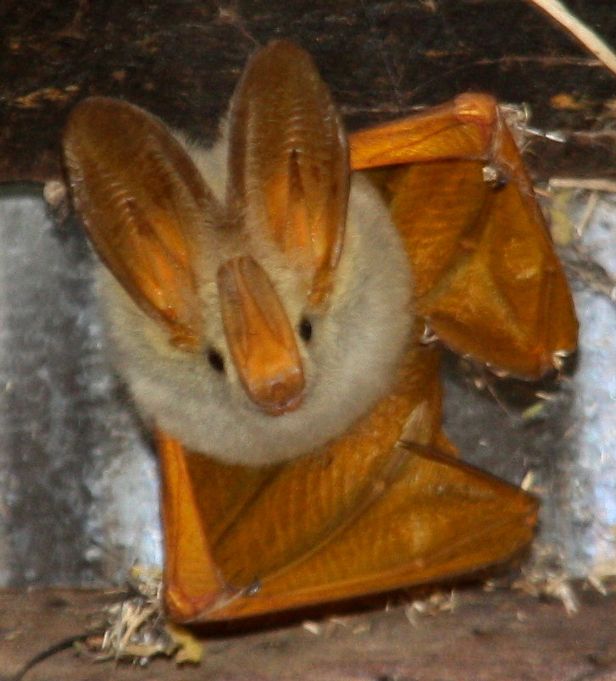
Many bat species harbor the malaria parasite. The bat in the picture, the yellow-winged bat, may not be one of those species, although it is endemic to Tanzania, which is a high-risk malaria zone (except for mountain areas, such as Kilimanjaro). Dries Sagaert took this picture and has made it available without restriction to the public.
Malaria is a killer. When it doesn't kill, it can rob people of productive lives. The disease targets the vulnerable especially--children chief among these. While malaria deaths were declining for a few years, to a low of 211 million cases in 2015, in 2016 the disease rebounded and numbers climbed to 216 million. In the very young, the death toll is dramatic. According to WHO, a child dies from malaria every two minutes. For those who survive malaria, especially children, long-term disability may be a consequence.
Chart of Malaria Global Mortality
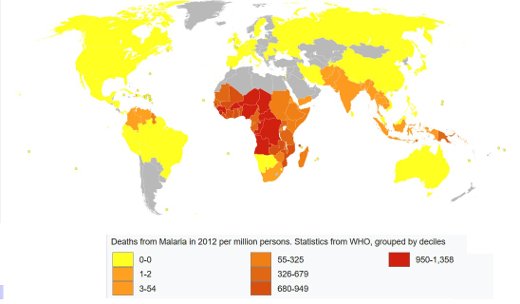
The map shows global mortality figures per million people in 2012, according to WHO. The picture is credited to Chris55. It is used under a Creative Commons Attribution-Share Alike 4.0 International license (Wikimedia Commons).
Chart of Malaria Global Disability
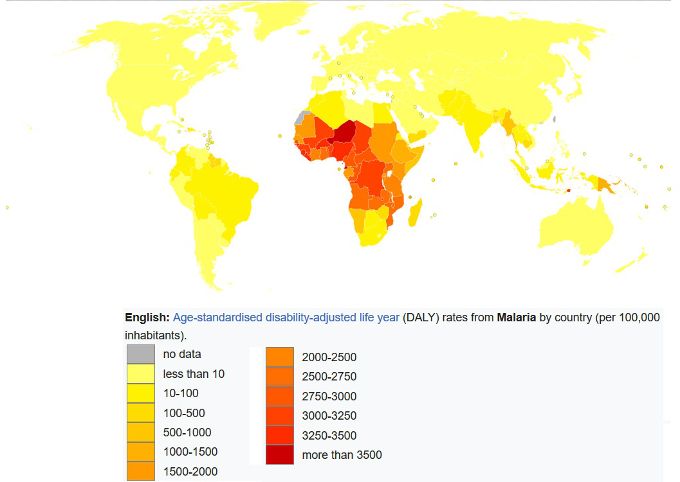
This map shows the toll in disability of malaria (2009) in different areas of the world. The statistics are from WHO. Image credit is Lokal_Profil on Wikimedia Commons. Used under a Creative Commons Attribution-Share Alike 2.5 Generic license.
While reference to the disease may be found in ancient texts, including those of the Chinese and the Greeks, today malaria can be treated and its transmission thwarted. There is a concerted effort afoot by government and non governmental organizations for the global eradication of malaria. In order for this effort to succeed there has to be better understanding of the mode of transmission, the natural environment in which the disease may flourish and effective treatment options.
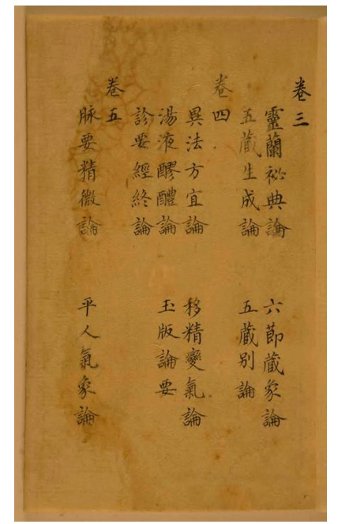
This is a page from an ancient Chinese text, the Huangdi Neijing, in which a description of a malaria-type illness may be found. The book is a medical resource that was revised by succeeding generations of Chinese physicians. It describes diseases, symptoms and treatments. This image is in the public domain, because of its age. The author unknown, downloaded from Wikimedia Commons.
Transmission
As was mentioned in the first paragraph, the vector, or means of transmission, for malaria is a mosquito, the Anopheles. There are different Anopheles species. These carry different species of the parasite, Plasmodium, that causes malaria. Not all species of Plasmodium are equal. Some are more deadly than others. Some have grown resistant to medications. Some are more likely to be found in specific areas of the world. But whatever mosquito delivers the parasite, and whatever the species of that parasite, the life cycle of the parasite is essentially the same. And while certain mosquitoes favor specific environments for breeding, a few elements are consistent across species. Mosquitoes need moisture to breed (not necessarily standing water). And they need a host to complete their life cycle.
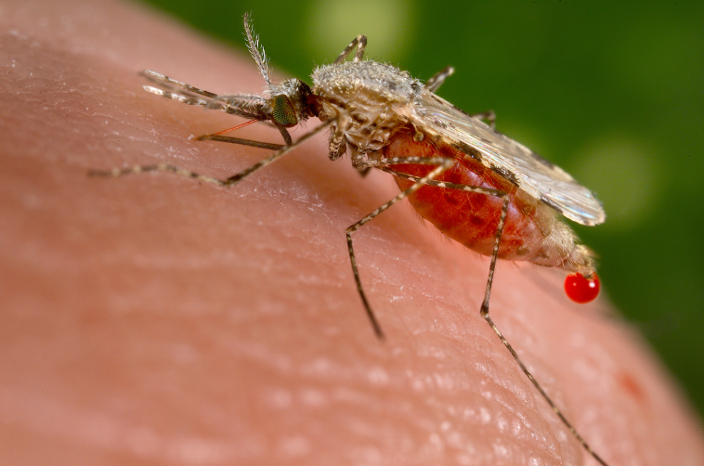
This is a CDC-generated photo of a mosquito feeding on a human host. According to the citation, this is an Anopheles stephensi, a species known to transmit malaria "from Egypt to China". I'm trying to imagine the circumstances under which the human volunteer was recruited. This is a public domain image on Wikimedia Commons.
If this disease were not such a scourge, the mechanism by which it is transmitted would seem to be a miracle of reproductive engineering. In order for the parasite to survive and propagate, it has to enter the mosquito, reproduce, and travel to the mosquito's saliva, all without doing harm to its host. The Anopheles must remain intact and healthy in order to continue its work as carrier of this deadly organism. It is not until the parasite reaches a human host that it begins to do significant harm. The diagram below illustrates the life cycle of Plasmodium.
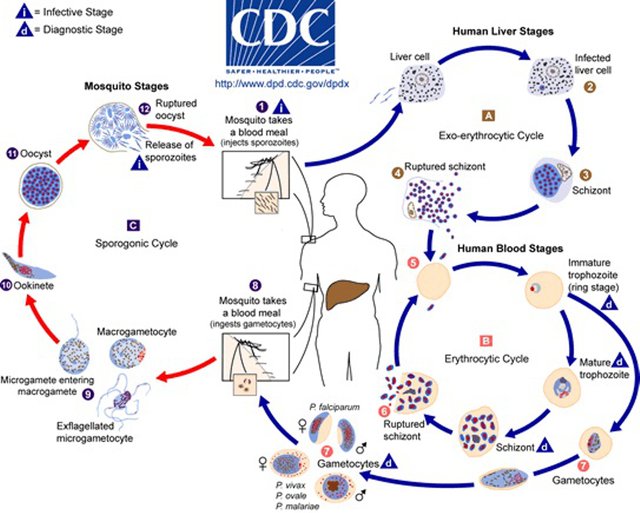
The picture shows a mosquito biting an infected person on the lower arm, ingesting blood with the parasite in it (in the form of gametocytes). The gametocytes mate in the mosquito. The resulting sporozoites travel to the mosquito's saliva. This infective saliva is injected into the next person the mosquito bites and the cycle begins again. A more detailed explanation of the different stages of reproduction and transmission can be found here. The diagram shown is derived from the CDC and is in the public domain.
Ecological Aspects of Malaria Transmission
While it is obvious that the presence of a human host facilitates reproduction of the Plasmodium parasite, the consequences of human activity may also offer a significant assist. For example, in British colonial India, irrigation canals were dug and railroads constructed in areas where there was already endemic malaria. While it was expected that clearing land would reduce malaria transmission, the opposite occurred. New regions began to experience malaria. Not only did an alteration of the area ecology increase malaria, so too, it is believed did the existence of labor camps. Workers who had never been exposed to malaria (and thus had no native immunity) were placed into congregate living conditions. The movement of people into and out of a malarial area is an efficient form of transmission.
.jpg)
This is a painting of the Ganges Canal, by William Simpson (1823-1899). The Canal was completed in 1854. In a book from Duke University Press, "Agrarian Environments: Resources, Representations, and Rule in India", by Arun Agrawal, it is explained that between 1877 and 1878, the Ganges Canal and its tributaries irrigated millions of acres. This enabled the cultivation of commercial crops such as opium, tea, cotton and indigo. These crops were grown for profit and not for domestic consumption. The painting above is in the public domain and was downloaded from Wikimedia Commons.
Eradication
This a long-term goal but one that both WHO and the Gates Foundation believe to be achievable. The Gates Foundation website gives a more detailed idea of how eradication might come about. A few key ideas:
- Development of new medications that will eliminate the parasite from the host. A better understanding of the parasite is essential for this to happen.
- Identification of asymptomatic individuals who can transmit the disease.
- Mosquitoes have developed resistance to chemicals controls. New, more effective insecticides must be developed. The parasite has developed resistance to standard medication (artemisinin and its derivatives) combinations. New preparations must be developed.
- Recognize that different species of mosquito thrive in different environments. Modify the ecology of areas with recognition of local conditions.
You received a 60.0% upvote since you are a member of geopolis and wrote in the category of "geopolis".
To read more about us and what we do, click here.
https://steemit.com/geopolis/@geopolis/geopolis-the-community-for-global-sciences-update-4
Thank you! And welcome back.